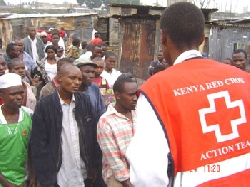
Contact: Kenya Red Cross Society, Linet Atieno, (254-20) 603593/608681/13, 0722-206958 cell, 0733-333040 cell, info@kenyaredcross.org
After a two week sabbatical, the rains resumed in November pounding the nation endlessly and what was first thought of as flash floods became a full fledged disaster as over 723,000 people were affected. The worst hit areas were the Coastal, the North Eastern and the Western regions.
According to media reports, over 126 people were killed by the floods and the numbers are still going up. By late November, IDP camps doted various parts of the affected areas as many people were displaced.
In North Eastern Kenya, the worst hit areas included Garissa, El Wak, Ijara, Moyale, Mandera and Daadab. Some of the areas were completely cut off for weeks on end. In Ijara for example, school children were unable to go home after schools closed due to inaccessible roads. Relief items provided by the government and other relief organizations could only reach the people through airdrops by hired helicopters.
Garissa District lies in an area of 33,620 KM², bordered to the east by Ijara district and to the south by
Infrastructure has been destroyed, livelihoods and lives lost. There are over five IDP camps in the area each with an average 600 families. Most of the camps are in an appalling state with poorly constructed temporary shelters scattered all over and no water and sanitation facilities on site. The roads are potholed and it is difficult for vehicles to get through to most of the areas. Some of the roads are muddy and many vehicles get stuck as they attempt to make their way into the interior parts of the town.
In the camps, the air is overcast as people attempt to look hopefully into the future that is not too bright. In one of our many trips to the area, we arrive at the Farmers Training Centre camp where there are over 315 households currently settled. We find a number of residents lining up to receive their daily ration of food. This is what will keep them going until they receive their next ration. For most people life must continue amid the poor conditions.
The area chief is in charge of distribution and most often has to be very strict in the camps since most people come from neighbouring villages to get food from there even if they have not been affected.
The area has experienced a lot of outbreaks and the Chairman of the Health Committee Mr Hamisi Radu said "Our greatest problems are with food and disease especially malaria and diarrhoea."
Sporting an ever present smile on her face she approaches us during. She is carrying her naked baby on her hip bone. She exchanges greetings with us and proceeds to pick up her water basin to wash in the bathroom.
Namkuu Ali is her name and she belongs to the Madogo Secondary IDP camp. This is how they have come to refer themselves … by the names of their camps. Seeing the confusion in our eyes, her step father makes it clear for us: "Huyu ni mwanagu amekuja kuniona," (this is my daughter, she has come to visit me). Namkuu, his step father and her child all live in one tent provided by the Kenya Red Cross Society. Her children have suffered flu and cholera as a result of the floods but these were minimal and now they are well.
Before the floods, she had a house, a small business and a unified family, however since the torrential rains began, they have lost everything but a few belongings they managed to salvage as they fled from danger. As she narrates her story, she still wears a bright and hopeful smile. She is 27 years old and a mother of four children "Three are with their father back in our camp," she clarifies. Giving us a sheepish look she reveals to us the real reason for her presence in the FTC camp; "My husband and I broke up and I want my step father to talk to him." They plan on making a trip to the Madogo camp to try and resolve issues among them. This proves that amidst the issues brought by the floods, life is still going on for the families.
Namkuu does not know what will happen to her once the floods subside. She has only heard that the government plans to relocate all the 981 households settled in
On the other end of the camp, Yusuf Ahmed is looking in the distance with a forlorn look in his eyes. He looks emaciated and weak and as the wind blows you can think he will be blown away. His kanzu ruffles in the strong wind as Yusuf Ahmed stares at one end of the FTC camp where people have lined up to receive food rations among other relief items. His hands are crossed over his chest and he has a gloomy expression in his face.
Yusuf does not know what he will eat today. Since he has not been registered in the FTC camp he cannot get any food from there. He has not eaten for a few days now and he had come to the FTC to see if he can get some food. He declares that food has not reached them since he and his family have not settled in an identified camp. Before the floods they were living in Bulafkin where he had a small farm with maize. However by the time they were displaces the whole farm was under water. Life is hard now though they have received some tarpaulins from the Kenya Red Cross Society for their shelter. The future does not look very hopeful for Yusuf and his family but they are hopeful.
The Kenya Red Cross Society continues to provide relief to the affected population in Garissa by providing water and health responses and relief items. However, it will take some time before these people are back to their normal lives.




 Sign Up to Receive Press Releases:
Sign Up to Receive Press Releases: